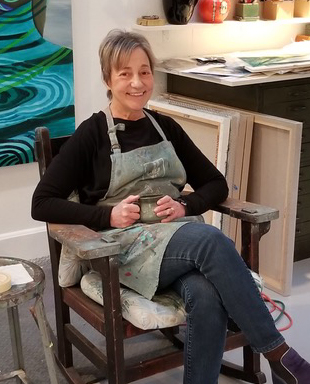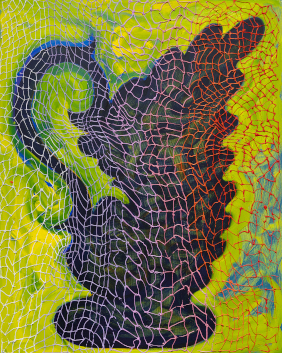Montserrat College of Art is a private, non-profit art college located in Beverly within Essex County of Massachusetts. The school is accredited by both the New England Commission of Higher Education and the National Association of Schools of Art and Design.
Amanda Means is an American artist and photographer. She currently lives and works in Beacon, NY.
No Hair Day: Laughing Our Way Through Cancer is a 1999 documentary film about a photo-shoot of three women undergoing treatment for breast cancer, which was broadcast on PBS on October 10, 2001, as part of the Independent Lens series and on WGBX-TV.
Stephen DiRado is an American photographer. His work is mostly black-and-white, and he makes frequent use of large-format cameras. He is most noted for his portraiture, night-astronomical photography, and semi-composed group photography, and for the extensive length of his projects.
Gary Schneider is a South African-born American photographer known for his portraiture and self-portraits. According to the John Simon Guggenheim Memorial Foundation, which awarded him a Guggenheim Fellowship in 2013, his "early work in painting, performance, and film remain integral to his explorations of portraiture. He strives to marry art and science, identity and obscurity, figuration and abstraction, the carnal and the spiritual."
Liz Deschenes is an American contemporary artist and educator. Her work is situated between sculpture and image and engages with post-conceptual photography and Minimalism. Her work examines the fluidity of the medium of photography and expands on what constitutes the viewing of a photograph. Deschenes has stated that she seeks to "enable the viewer to see the inconstancy of the conditions of display, which are always at play but sometimes hard to see." Her practice is not bound to a single technology, method, process, or subject, but to the fundamental elements of photography, such as light, paper, chemistry, and time.
Rachel Perry is an American artist. She is known for conceptual works using drawing, photography, video, collage, sculpture and performance, which address “the fleeting nature of experience, the elusiveness of desire, and the persistence of objects in a throwaway culture.” Art critic Jerry Saltz has written that her work "not only grappl[es] with consumerism but [she is] just about swallowed whole by it.” Her work also considers themes of gender identity, narcissism, privacy and information overload.
Lana Z Caplan is an American interdisciplinary artist working with photography, video, film and interactive media installations.
Amanda Maciel Antunes is an LA based multidisciplinary artist working in painting, costuming, performance, writing, and installation art. She was born and raised in the countryside of the state of São Paulo, Brazil.
Sage Sohier is an American photographer and educator.
Jocelyn Lee is an American contemporary artist and photographer currently based in Portland, Maine and Brooklyn, New York.
Barbara Bosworth is an American artist, educator, and photographer. She works primarily with a large-format, 8x10 view camera and focuses on the relationship between humans and nature. Bosworth's works have been included in magazines, journals, books and permanent collections, and shown in solo exhibits nationally and internationally. In 1985, she won a Guggenheim fellowship for her photographic work.

Barbara Grad is an American artist and educator, known for abstract, fractured landscape paintings, which combine organic and geometric forms, colliding planes and patterns, and multiple perspectives. Her work's themes include the instability of experience, the ephemerality of nature, and the complexity of navigating cultural environments in flux. While best known as a painter, Grad also produces drawings, prints, mixed-media works and artist books. She has exhibited in venues including the Art Institute of Chicago, Kemper Museum of Contemporary Art, Danforth Art, Rose Art Museum, Indianapolis Museum of Art and A.I.R., and been reviewed in publications, including Artforum, Arts Magazine and ARTnews. Grad co-founded Artemisia Gallery, one the country's first women-artist collectives, in Chicago in 1973. She has been an educator for over four decades, most notably at the Massachusetts College of Art and Design. Grad has been based in the Boston area since 1987.
Deborah Bright is a 20th-century American photographer and artist, writer, and educator. She is particularly noted for her imagery and scholarship on queer desire and politics, as well as on the ideologies of American landscape photography. Her work is in the collections of the Smithsonian American Art Museum, the Fogg Art Museum, and the Whitney Museum of American Art. Bright's photographic projects have been exhibited internationally.

John Dilg is an American painter based in the Midwest. He is known for idiosyncratic landscapes that use a pared-down visual vocabulary drawing on imagination, vernacular artifacts, folk art and art historical sources. Critics describe them as dreamlike ruminations on place, the fragility of nature, the collective unconscious and mystical storytelling. Precedents for his work that have been cited include 19th-century Romantic landscape painters, Marsden Hartley, Georgia O’Keeffe and Horace Pippin, and the imaginary vistas of Henri Rousseau.

Vanessa Platacis is an American contemporary artist, known for her large scale painting installations and her paintings and performance art. Platacis hand draws and cuts stencils that are used to paint directly onto walls using a variety of spray paint and graffiti techniques. Her work has been featured in galleries and private collections in Boston, Cambridge, Los Angeles, Miami, New Mexico, and France as well as the SCOPE Art Show in Basel, Switzerland. Currently, she lives and works on an island off the coast of Savannah, GA and teaches painting at the Savannah College of Art and Design.

Jayce Salloum is a Canadian multidisciplinary artist.
Winsom is a Canadian-Jamaican Maroon multi-media artist working in textiles, painting, video, installations, and puppetry. Her work explores human spirituality.

Heide Fasnacht is a New York City-based artist who works in sculpture, drawing, painting and installation art. Her work explores states of flux, instability and transformation caused by human action and natural events. Since the mid-1990s, she has been known for sculptures and drawings that recreate momentary phenomena such as sneezes, geysers and demolitions—in sometimes abstract or cartoony form—that are temporally and spatially "frozen" for consideration of their aesthetic, perceptual, social or sensate qualities. In the late 2010s, she has expanded these themes in paintings that examine lost and neglected childhood sites, such as playgrounds and amusement parks. ARTnews critic Ken Shulman has described her work as "chart[ing] the fluid dialogue between second and third dimensions, motion and inertia, creation and ruin."

Wendy Edwards is an American artist known for vibrant, tactile paintings rooted in organic forms and landscape, which have ranged from representation and figuration to free-form abstraction. Her work has been strongly influenced by the 1970s Pattern and Decoration movement and its embrace of ornamentation, repetition, edge-to-edge composition, sensuality and a feminist vision grounded in women's life experience. Critics note in Edwards's paintings an emphasis on surfaces and the materiality of paint, a rhythmic use of linear or geometric elements, and an intuitive orientation toward action, response and immediacy rather than premeditation. In a 2020 review, Boston Globe critic Cate McQuaid wrote, "Edwards's pieces are exuberant, edgy, and thoughtful … [her] sweet, tart colors and delicious textures make the senses a gateway into larger notions about women and men, creation and mortality."








